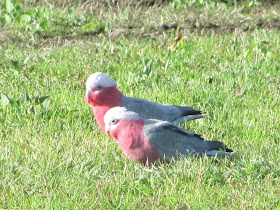 |
| View towards the eastern suburbs of Geelong From Tait's Point |
Tait's point wasn't a whole lot more successful. Not long after I arrived, a number of birds started wheeling overhead. At a glance they were ducks, but what variety I have no idea, and thanks to the two council employees with their tractors who chose to park their vehicles for lunch at the top of the boat ramp, the "ducks" weren't hanging around to let me identify them.
Meanwhile, one solitary swan was drifting around off the shore and two jetties and a log boasted cormorants - Little Blacks and Little Pied. (Incidentally, the collective noun here it seems is generally a "flight" of cormorants, however I did see a "mess" and a "gulp" suggested, which are much more amusing - to me anyway. I doubt the cormorants care either way.)
On a slightly more successful note, I may have spotted an egret trying to hide amongst the cormorants. I wasn't close enough to get a decent photo so my criteria for identification were a large (in comparison to the cormorants) white blob, with a pointy yellow blob where the beak should be and no sign of legs, which I took to mean they were grey.
 |
| Galahs at South Barwon Reserve |
On the way home, I detoured past the South Barwon Reserve to have a look at the bottom end of Waurn Ponds Creek where it enters the Barwon. There were a large number of bullrushes, lots of soggy ground and I really couldn't get close enough to see where the creek entered the river. Instead I amused myself taking photos of the Straw-necked Ibis who had decided that one of the ovals at the reserve was their personal feeding ground and a pair of rather brightly coloured Galahs who weren't overly concerned with my presence.
So much for the birds. What of the weather? There are various websites which give chapter and verse on the effects of rainfall on the Barwon River system: for example, the City Of Greater Geelong website. It would seem that on a wet catchment - which I imagine is currently the case - 75mm of rain over a few days is enough to cause flooding, or 150mm when the catchment is dry.
However, it is not only the river height and those of us who run, walk, ride along it which are affected by the weather. I am informed that redfin - an introduced species of fish common in the Barwon and which I have fished from the Moorabool River myself in the past - are also sensitive to the weather on a day to day basis. It seems that they like a rising barometer and fine weather - don't we all? Under these circumstances the fish are biting and a good catch is likely. When the barometer is falling, the fish are likely sulking on the bottom of the river and not about to be enticed by a tasty worm or a flashy lure. My own observations suggest that in general, the bird life is no more keen on being out and about in bad weather than the rest of us. It is only the hardy, the hungry or the waterproof who brave wet and wintry conditions and with the forecast for the coming week providing no sign of relief, I may have to wait a while to find those ducks.
And of course, I am now left wondering...what exactly is "good weather for ducks?"
So much for the birds. What of the weather? There are various websites which give chapter and verse on the effects of rainfall on the Barwon River system: for example, the City Of Greater Geelong website. It would seem that on a wet catchment - which I imagine is currently the case - 75mm of rain over a few days is enough to cause flooding, or 150mm when the catchment is dry.
Certainly, the prolonged drought and accompanying weather patterns from which we have just emerged have had a drastic effect on the health of the river and its denizens. A 2007 study by Deakin University examined the problem, indicating that reduced water flows would impact on salinity levels and plant life, in turn impacting on food sources for fish and water birds. For residents of Geelong and surrounds, there was the obvious impact of water restrictions as levels in the West Barwon Dam fell.
 |
| Fisherman at Barwon Heads |
And of course, I am now left wondering...what exactly is "good weather for ducks?"
No comments:
Post a Comment